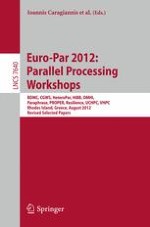2013 | Book
Euro-Par 2012: Parallel Processing Workshops
BDMC, CGWS, HeteroPar, HiBB, OMHI, Paraphrase, PROPER, Resilience, UCHPC, VHPC, Rhodes Islands, Greece, August 27-31, 2012. Revised Selected Papers
Editors: Ioannis Caragiannis, Michael Alexander, Rosa Maria Badia, Mario Cannataro, Alexandru Costan, Marco Danelutto, Frédéric Desprez, Bettina Krammer, Julio Sahuquillo, Stephen L. Scott, Josef Weidendorfer
Publisher: Springer Berlin Heidelberg
Book Series : Lecture Notes in Computer Science
